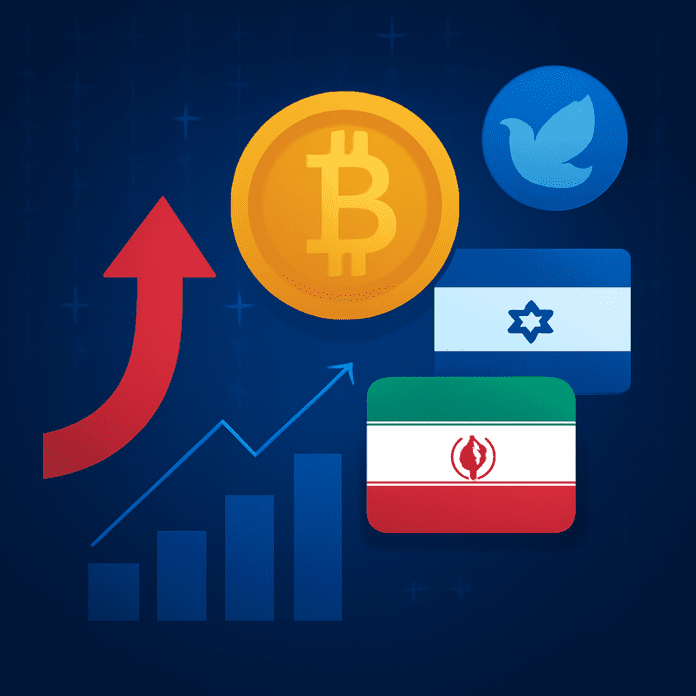Crypto news has been hotly debating the happenings in the Middle East. As Iran and Israel teeter on the brink of war, investors at home have been wondering what kind of impact that this dispute will have on crypto markets.
In a major step forward for the marketplace, President Donald Trump announced a ceasefire, a pause in the rising conflict between the two nations. “It has been fully agreed by and between Israel and Iran that there will be a complete and total ceasefire,” Trump wrote on his Truth Social account. The following morning, he announced that the ceasefire was “now in effect.”
Good News for Crypto
While it is obviously good news that there will be no further violence in this matter, there is also good news for the greater cryptocurrency market. Bitcoin, the leader of the industry, jumped by 2% immediately following the ceasefire announcement. It climbed from $104,000 per token to more than $106,000.
Other cryptocurrencies have benefitted as well. XRP, for example, gained more than 5% in the same period. Ethereum gained 6% and Solana gained 3% while the entire market added 3% to its market cap, rising from $3.19 trillion to $3.27 trillion.
CEO of crypto asset manager Wave Digital Assets David Siemer commented, “We’re seeing Bitcoin surge back to $105,000 and other major currencies like Ethereum, Solana, and XRP showing strong rallies of their own. This is largely due to easing tensions in the Middle East after the U.S.-brokered ceasefire between Israel and Iran.”
A Threat of War
This is just the latest conflict in a string of them going back to the beginning of June. A nuclear watchdog backed by the United Nations released a report claiming a lack of compliance with current nuclear safeguards on the part of Iran. Not long after the release of the report, Isreal launched a number of airstrikes on June 13. It targeted Iran’s nuclear sites and ultimately ended up killing top Iranian officials.
Since then, there has been a looming threat of all-out war between the two. This only became worse when Iran retaliated against Israel’s strikes, launching a series of airstrikes of its own accord. The two continued to exchange fire. Things only got worse when it was announced by Trump that the U.S. military had executed a number of airstrikes, targeting several Iranian nuclear sites during weekend strikes.
Trump said following the attack on Truth Social, “We have completed our very successful attack on the three nuclear sites in Iran. A full payload of BOMBS was dropped on the primary site, Fordow.”
News of U.S. involvement resulted in investors moving away from volatile assets, cryptocurrencies being primary among them. Bitcoin dropped to $100,000 for the first time in more than a month with investors bracing for an Iranian response.
Whether the ceasefire holds remains to be seen. There is no indication of peace between the two nations, but cryptocurrency holders are happy for some stability in the marketplace.
Siemer continued by saying, “There is reason to believe that markets may continue to be reactive over the next few weeks. Institutional players in the digital asset space are closely watching developments and assessing their risk appetite.”
Historical Context of War and How it Impacts Crypto
There is some historical context that crypto investors can turn to for reference. After all, we are still in the midst of the Russia-Ukraine war, which began back on February 22, 2022, with the invasion of Ukraine by Russia.
At the time, there was discussion as to whether Bitcoin could become a ‘safe haven’ investment. The week following the Russian invasion, BTC jumped by 18% with the Dow Jones industrial being largely unaffected. Just a few months later, the US Federal Reserve started to raise interest rates in order to combat inflation which came as a result of the ‘free’ money market surge of COVID.
From March to December 2022, the Fed raised rates seven times. During that time, Bitcoin price fell by more than 65%, going from a high of $47,062 per token to $16,818. It is also worth nothing that the Dow also dropped nearly 6,000 points in that span, roughly 17%.
All of this leads to the million-dollar question, “What does this current dispute mean for cryptocurrency and Bitcoin?” With historical context coming not only from the Russia-Ukraine dispute but also from COVID, we have a general idea of how the market responds to major global crises.
Bitcoin has historically had great volatility, especially in times of uncertainty. Prices moved down during COVID but surged upward during the Ukraine invasion. That said, prices returned back into the pre-event range in both instances.
Things have changed with the crypto marketplace since then, however. Greater institutional investing – including the creation of a U.S. cryptocurrency reserve – has seen a surge in Bitcoin price. It is considered more of a safe haven investment than it was even three years ago.
Historical data suggests that quick surges in one direction or the other are common following major events like this. Prices eventually correct themselves and crypto carries on as normal. Fed Chairman Jerome Powell has also noted that there will be two interest rate reductions coming over the remainder of 2025. That could result in a general positive influence for Bitcoin and the marketplace overall.
The Future of the Iran-Isreal Conflict?
The question remains, “What does the future hold in this conflict?” Will the ceasefire hold and lead to peace or is it simply a stopgap before hostilities continue? The attacks on Iran by both Israel and the United States have left the nation essentially sidelined as far as being a nuclear threat.
Given the reaction of the U.S., it seems that there will be considerable force if Iran attempts to rebuild its stores. There are two important takeaways from this move, the first of which is that Israel and the U.S. show that they’re okay using force if they feel it is necessary, even if other countries aren’t offering their support. They’ve also shown the people of Iran that the current regime can be challenged, laying the groundwork for other forces to attempt an overthrow.
Could this lead to a nuclear deal with Tehran? It is possible that we see a deal in which Iran agrees to stop pursuing a nuclear program. This would be in exchange for the lifting of sanctions with Iranian commitments being monitored to make sure that it isn’t aiming to become a nuclear state.
Despite the obvious tensions, this could be a move toward a more stable Middle East. If this leads to continued peace and the removal of Iran as a potential nuclear state, it could be a net win. It could also improve the chances of a more normalized relationship between Israel and Iran, though this is far from the end of the road. The next steps will be critical ones and they will no doubt impact the immediate future of the crypto marketplace.

